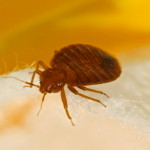 The BBC news today reports that a library in Ealing has had to close temporarily due to bed bugs and this, worryingly, comes shortly after a widely reported outbreak of bed bugs in Paris in October.
The BBC news today reports that a library in Ealing has had to close temporarily due to bed bugs and this, worryingly, comes shortly after a widely reported outbreak of bed bugs in Paris in October.
[https://www.bbc.co.uk/news/uk-england-london-67284766]
[https://time.com/6322485/bed-bugs-paris-other-cities/]
What is a bed bug?
Cimex lectularius is the common bed bug. They are commonly reported to be the size of a lentil or apple seed and are flat when unfed and more swollen and elongated when fed. They feed on blood, usually at night time, of human or any other warm-blood animal’s blood. They have been associated with humans for thousands of years. It is thought that spring cleaning may have begun as a practice to clear out bed bugs after the winter and before bed bugs became more active in the spring and summer.
Where are bed bugs found?
They are not only found in beds. They are found in other furniture such as sofas and chairs as well as more esoteric things such as picture frames, wallpaper and inside electrical switch plates. They have been found in schools, offices, public transportation and hospitals.
Why are we getting outbreaks now?
Well, bedbugs never really went away. There was a huge outbreak in New York in 2010 and similar outbreaks have been reported all over the world. The main reason for the resurgence now has been the boom in travel since the pandemic together with widespread resistance amongst bedbugs to pesticides.
[Freedman A, McDougall L, Lamy P. Bedbugs. CMAJ, 2023; 195(20):E709.]
Resistence to pesticides?
Yes, the pesticides DDT and organophosphates were initially very effective at eradicating bed bugs, so much so that between the 1940s and 2000s, bedbugs were almost eradicated. However, when these chemicals were banned from being used indoors due to concerns over human health, bedbugs just flourished again and the subsequent generations of bedbugs were highly resistant to any chemicals used to treat them.
The widespread use of pesticides created a selective evolutionary pressure on these bedbugs to evolve so that they could neutralise the toxins meant to kill them. They also developed harder exoskeletons to prevent the chemicals from entering their bodies and they also changed the way they walk so that the amount of bed bug body that comes into contact with the surface they walk over is very small. We’ve also removed the cockroach, one of the bed bugs’ main predator.
So how can we get rid of them?
Bedbugs have anecdotally been associated with poor hygiene or disadvantaged communities but they are literally found everywhere from first class airline seats to high end apartments. They persist in certain places because bed bugs are difficult to eradicate and it is costly to call in professional help and those with limited resources struggle with this aspect.
Are there health concerns with bed bugs?
Other than causing itchy, red spots at the site of the bite and the distress of having been bitten by bed bugs, there are no real health concerns. The bites generally resolve after a couple of weeks once exposure to bed bugs is stopped. Bed bug bites have not been found to transmit diseases to humans.
What can we do to prevent getting bed bugs?
So if you are staying in a hotel or Airbnb, check the mattress for the red-brown stains of their poo and look for the bugs themselves. Check around the headboard as they commonly live in the joints of furniture or where a headboard is attached to a wall.
Don’t put your luggage on the bed or on the floor but on the luggage stand away from the wall. If you stay somewhere with an infestation, when you go home, don’t bring your luggage inside. Take your clothing out and wash them and then put them in the tumble dryer on hot for at least 30mins. Then seal the clothing in a plastic bag and leave for a few weeks for any eggs to hatch. Vaccuum or steam the inside of your luggage and dispose of the contents in a sealed container.
However, if you do find bedbugs in your own home, the general advice is to get in a professional.
Kind regards,
Sandy
Dr Sandy Flann, Consultant Dermatologist.
